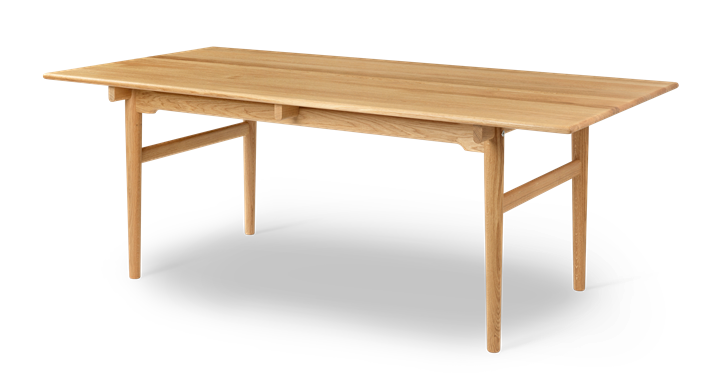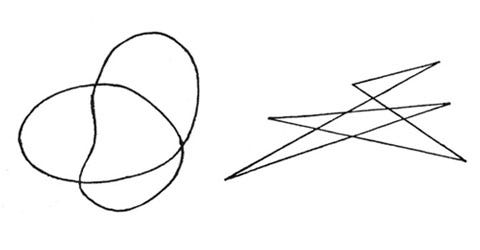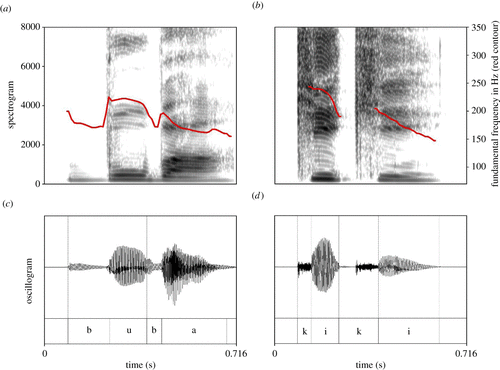The Bouba-Kiki Effect Is Real. So Is Language Still Arbitrary?
(the linguistic interplay between sounds, shapes, and... vibes?)
Thanks for reading Everybody Talks, the newsletter all about language and our rich linguistic world. If you stumbled across this page without having subscribed, why not do so now? I send out newsletters twice a month.
Maybe you’ve already seen this image of two shapes — one spiky, one curvy.
One of the shapes is bouba, and the other is kiki. It’s up to you to decide which is which. What does your gut say?
It’s one of those silly internet-famous questions that has joined the ranks of “What color is this dress?” and “Laurel or yanny?”
(quick!!!! make a decision now!!!)
…
Overwhelmingly, respondents attribute the pseudoword bouba to the blobby shape, and kiki to the spiky one. It feels right. It just makes sense.
But anyone who's taken a Linguistics 101 course might timidly raise their hand at this point, because there actually is something a bit odd about all this bouba-kiki business.
The issue is this: If one of the characteristics of language is that the relationship between form and meaning is arbitrary, doesn’t this clash with how readily we assign the words bouba and kiki to certain shapes?
Are Words and Meanings Entirely Arbitrary?
The Case for Arbitrariness
First, let's examine what exactly arbitrariness refers to when we talk about language.
Here's the main idea. There is nothing inherently “table”-y about the image below.
We might know it as a table, but there is nothing in its nature that makes us clasp our hands knowingly and declare, "But of course, because of the very essence of this thing, it’s only natural for me to string together a /t/, the diphthong /eɪ/, a schwa, and an /l/.”
This notion — the arbitrariness of the linguistic sign — explains why the above image is not just a table: it's a mesa (Spanish), pono (Twi), and clàr (Scots Gaelic).
And this idea applies to both spoken languages and signed languages, because signing isn't just gesturing or playing charades. (If it were, then speakers of American Sign Language and Japanese Sign Language would be able to understand each other.)
The Case Against Total Arbitrariness
So far, this all feels pretty straightforward. But are there any ways in which language can be nonarbitrary?
There are two main ideas to be aware of here - systematicity and iconicity.1
Patterns in Language
First, systematicity examines statistical regularities that occur between similar sounds and similar meanings.
In English, for example, there are a suspicious number of words beginning in "gl" that all have something to do with light: glimmer, glint, glare, and glow, for example.
There's nothing innately light-like about "gl," and there are still words out there like glue, gland, and gluten, but it’s a pattern between sound and meaning that we can certainly point to.
Resemblance in Language
The second idea is iconicity, which refers to when form and meaning in language resemble each other.
Onomatopoeia is the clearest example of this, because it attempts to actually sound like the thing that it refers to.
Even so, we are restricted by our very human larynxes, which is why we get dogs that say "bark" and "woof," but also wan-wan (Japanese), voff (Swedish), and ham (Albanian).
If you dig a little deeper into iconicity, you'll find that the literature distinguishes quite a few types. Indirect iconicity, for example, is more about connections between impressions, rather than direct imitation like onomatopoeia.2
This allows us to expand our thinking to not just sound and meaning, but also to other associations like shape, size, and… overall vibes.
Making Sense Of Bouba and Kiki
A Brief Summary of the Research
100 years before bouba and kiki, Edward Sapir (yes, that one!) observed that high-front vowels, like in the pseudoword mil, were attributed more frequently to smaller objects. Its low-back vowel counterpart, mal, was associated with larger objects.3
German psychologist Wolfgang Köhler published a similar study that same year, featuring blobby and spiky shapes, and the pseudowords baluba and takete (which later evolved into maluma and takete).4
Our internet-famous bouba and kiki, which take after maluma and takete, aren’t that new (they come from a 2001 study by Ramachandran and Hubbard5).
Clearly, we’ve been thinking about the relationship between sounds and shapes for a while. And over the last few decades, the research has grown even more robust.
Why Does This Effect Exist?
So what causes the bouba-kiki effect? Perhaps it's a cognitive remnant of our early linguistic evolution. We certainly feel that soft rounding our our lips when we make the bilabial /b/ and the long “oo” in bouba, contrasted with the sharp, bright velar plosive /k/ and the high front “ee” in kiki.
Beyond vibes and mouth shapes, it might make sense to hypothesize that there’s something to do with the visual, written aspects of the pseudowords bouba and kiki. (Bouba has more curves, and kiki has more straight lines sticking out.)
But a notable 2021 study examined the bouba-kiki effect across 25 languages —covering nine writing families and 10 writing systems — and found that the effect actually holds up really well, even for speakers of languages that don't use the Roman alphabet.6
Other studies, such as one with non-literate speakers of Himba in Namibia, echo this finding.7 This tells us that the effect is not contingent on your language’s writing system — it goes a little deeper than that.
There are a few exceptions in the research of languages whose users don’t experience the bouba-kiki effect as strongly, like Syuba speakers in Nepal and Hunjara speakers in Papua New Guinea. But for the vast majority of people, this effect is strong.
Bouba and Kiki Expand Our View of Language
How does this all fit into our discussion on the arbitrariness of language?
Fundamentally, language is arbitrary, but it’s also really human for us to seek out patterns and draw subconscious connections across modalities. It makes sense cognitively, too — language processing involves multiple regions of the brain.
You could even argue that a purely arbitrary language would be more difficult to learn, and is more unnatural than a language that has patterns and associations.
Dingemanse et al. (2015) put it this way:
A fully arbitrary vocabulary is unlikely to be a stable feature of natural languages, because form-to-meaning correspondences are shaped by cultural evolutionary processes which favor... learnability and communicative utility.
So, does the bouba-kiki effect ruin everything we thought we knew about the nature of language? Not at all.
Rather, it helps us hold two truths at once: language is fundamentally arbitrary, but our human-ness creates some exceptions that just make sense.
Maybe what makes bouba and kiki so fascinating is that they expand our understanding of language, illuminating something incredibly human that was inside of us all along.
Thanks for Reading!
Had you heard of the bouba-kiki effect before this article? I would love to hear your thoughts and reactions in the comments below.
In classic internet fashion, bouba and kiki are taking on new life as a personality type. I’m definitely more of a bouba. Which one are you?
 Tiktok failed to load.
Tiktok failed to load.Enable 3rd party cookies or use another browser
Thinking of a language fan who would love this newsletter? Share this piece with them and get the conversation going!
If you read this far and haven’t subscribed yet, why not do so now? I send out newsletters twice a month about language and our rich linguistic world.
Until next time,
Rebecca
Dingemanse, M., Blasi, D. E., Lupyan, G., Christiansen, M. H., & Monaghan, P. (2015). Arbitrariness, iconicity, and systematicity in language. Trends in Cognitive Sciences, 19, 603–615.
Sidhu, D. M., & Pexman, P. M. (2018). Five mechanisms of sound symbolic association. Psychonomic Bulletin & Review, 25(5), 1619–1643.
Sapir, E. (1929). A study in phonetic symbolism. Journal of Experimental Psychology, 12, 225–239.
Köhler W. (1929) Gestalt psychology. New York, NY: Liveright.
Ramachandran, V. S., & Hubbard, E. M. (2001). Synaesthesia: A window into perception, thought and language. Journal of Consciousness Studies, 8, 3–34.
Ćwiek A. et al. (2021) The bouba/kiki effect is robust across cultures and writing systems. Phil. Trans. R. Soc. B 377: 20200390.
Bremner A. J., Linnell K., Caparos S., Spence C., de Fockert J.W., Davidoff J. (2013). ‘Bouba’ and ‘kiki’ in Namibia? A remote culture make similar shape–sound matches, but different shape–taste matches to westerners. Cognition, 126, 165-172.









This is a fascinating read. Before I read the explanation, I identified the curvy shape as Buoba and the more sharp shape as Kiki. My reasoning was that bouba reminded me of “blob” or “blubber” and the sound was more round. And Kiki had harder and sharper consonants, then it was repetition i-i, straighter and more direct in its sound. So, I associated it with the other shape.
I think about this topic all the time. Mainly because I associate the combination of sounds to colors and shapes. When I read, a passage can seem yellow or gray. There is an aesthetic quality — just as when I look at a tree or a fruit, the image itself can be pleasing or displeasing.
Really cool! I haven't heard of 'bouba' vs 'kiki' before. It reminds of how 'm' is the most common consonant phoneme across languages, and is also most commonly used in the word 'mama'. There must be some physiological explanation to this and to the bouba vs kiki effect.